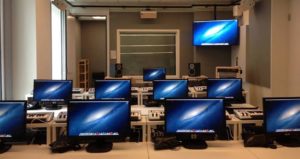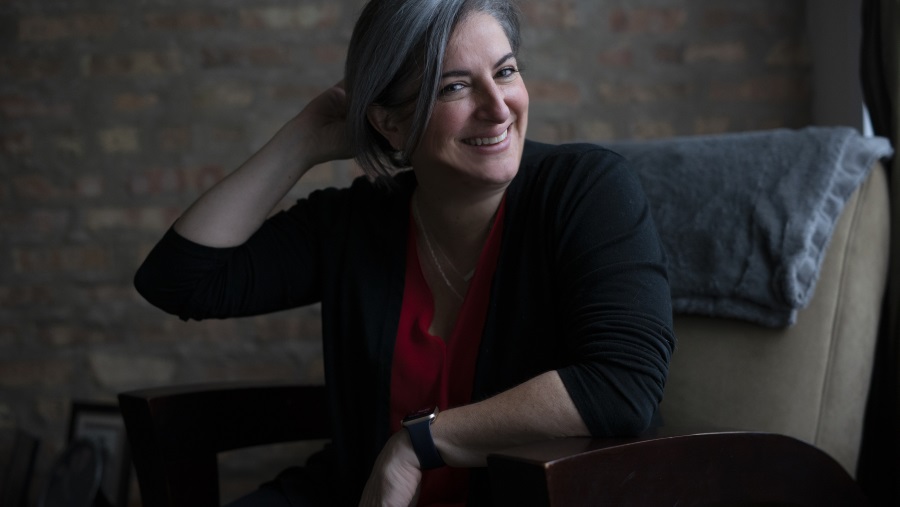When you’re in high school, sound design can seem so simple. There’s nothing too complicated, after all, about plugging an iPod or computer into a mixing board and cranking up the volume; even if you’re using a program like QLab, it’s still mostly press and play. But that’s not really sound design, of course, any more than high school acting is really acting. The training involved to do it on a professional level involves learning about music, science, script analysis, and even social skills.
While educators at both undergraduate and graduate levels agree that going through an official sound design training program isn’t the only way to make it in the industry, training can definitely allow for a smoother entrance into an already difficult field. Those who hope to make a living as a sound designer may find themselves working on anywhere from 10 to 20 shows in a year, if they can get the gigs. Chicago-based sound designer Victoria Deiorio, who runs a sound design program she helped create at DePaul University in Chicago, offered a general disclaimer: Sound design is a tough career, and, like many creative jobs, should be something you really want to do if you’re going to pursue it. Deiorio added that the difference between going to school or learning on the job depends on where a young sound designer wants to put their “safety net.”
“In school,” said Deiorio, “you have the ability to make missteps and crumble, in a sense, without too much consequence on whether you’re going to get paid, whether your not you’re going to have a job, or whether or not you will have burned a bridge. It’s an environment where you can test things out without too much consequence if you fail.”

In school, the room to fail includes the chance to experiment with different levels of equipment—not always the state-of-the-art digital sound boards, necessarily, as that’s not the reality out in the world—and to branch out artistically. Since sound designers are responsible for taking audiences on an aural and emotional journey, Deiorio added that an interest in human nature is important when deciding to work in the theatre.
“You have to really understand history and anthropology and sociology and psychology and the physiology of how sound waves hit the body,” said Deiorio, who authored The Art of Theatrical Sound Design: A Practical Guide, a sound design training book. “If you like all of those things, then it’s definitely the career for you. If you like psycho-acoustics then it’s totally the career for you.”
Expecting to find young designers or students with a knowledge of all of those areas is a tall task. That’s why programs like the masters program David Budries runs at the Yale School of Drama set out to find students of varying backgrounds and interests to complement each other. With just three students chosen per class, Budries said he tries to get one student who is more oriented toward the technological and engineering side of sound design, one who leans more toward musical composition, and one who falls somewhere in between.
“I have discovered over the years that the integration of different ideas, different dramaturgical approaches, just different mindsets is hugely important to the diversity of the individual classes,” Budries said.
In the classroom, those differing voices are able to bounce ideas off each other and grow based on the strengths of their fellow students. Deiorio, who had conversations with Budries, among others, as she crafted DePaul’s undergraduate sound design curriculum, also employs this strategy, noting that varied voices are crucial as the sound design field moves toward diversifying its workforce. Porsche McGovern’s HowlRound study of design positions in League of Resident Theatre (LORT) theatres between 2012 and 2017 found that 86.4 percent of sound designers were men, and that those men took up 89 percent of all sound design jobs. (The number jumps to 96 percent if you look at Broadway employment during the 2017-18 season, according to data collected by ProductionPro.)
More variety in the background and interests of sound design students means that the training programs are able to provide a necessarily comprehensive training in all things “sound design and engineering” while also allowing students the flexibility to explore their specialties and affinities. According to sound designer Sun Hee (Sunny) Kil, assistant professor at SUNY New Paltz, computer software like Logic Pro and Garage Band makes it easier for students to craft music and soundscapes. While it’s not essential that all students come out as expert composers, it’s important that they have the tools to realize their ideas.
“Students need to get trained to express the emotions or drama in each scene,” Kil explained. “Only sound can make the emotions. We are the psychologists, we are the manipulators—we are the people who can tell the story and really tie it to the audience.”

To that end Kil has her students study music, theatre, and piano, all to help learn the connection between the aural world and human emotion. Students also have to take engineering and physics classes too to better understand the science of sound. As Kil pointed out, “There are many sound engineers who have no sound education out there; they start learning from the shop or touring companies.” Kil said those engineers are missing out on important foundational knowledge.
That’s not to say that bypassing traditional schooling, or joining the sound design game late, can’t work out in the end. Deiorio herself was a ballet dancer who pursued musical theatre as an undergraduate. She had moved to Chicago thinking she’d be an actor and director (she still occasionally does both), but the sound design world, she says, “chose her.” She considers her first three years working in the field to have been her training. It shouldn’t be much of a surprise, then, that Deiorio, in both her book and her program, emphasizes teaching young sound designers how to collaborate and express themselves.
“I remember there were times that I did things or said things that were my young, rash mind—what I thought was the right thing at the time,” Deiorio confessed. “You burn bridges. I didn’t want that to happen for the sound designers who were starting out.” She hopes to give her students the ability to clearly and diplomatically “speak to why you want something in a show or why something may not be the best fit for the delivery of that emotion to an audience.”

Effective communication of ideas becomes even more important when considering how difficult it can be for young sound designers to prove their worth to new companies. Sound engineering and soundscapes are so intrinsically tied to their productions that simply playing a director or producer a sound can’t possibly carry the same weight as that sound did in the context of a play.
Kil, who served as the associate sound designer for the opening and closing ceremonies of the 2018 Winter Olympic Games in PyeongChang, recommends that young designers put together a website and portfolio of photos and documentation from previous productions. She advises students, if they didn’t compose the music, to take pictures and include diagrams so people can see the size of the production and the setup. Then, as sound designer Jeremy Lee says, comes talking about that work.
“As a sound designer,” said Lee, former head of the sound design program at the University of Cincinnati’s College-Conservatory of Music, “you have to get really good at communicating your ideas clearly. The people who are going to be hiring you as a designer are directors and producers, so they want to know what your process is.”
Lee notes that summer stock theatres and internships that rely on student talent pools are great opportunities to build relationships with more experienced sound designers. (Kil equates this to the restaurant industry—it’s smart to work in a restaurant and see how it’s run before trying to own your own place.) Those connections, in a world as small as the theatre world, may be conversation starters in interviews down the line. Once out of school and working in the industry, Lee explained, it’s all about who you’ve known and worked with and the relationships that have been built.
Once relationships are established, the skills learned as a sound designer can translate to jobs in many entertainment industries, not just legit theatre. Deiorio said she’s had students go on to work on cruise ships, with Cirque du Soleil, and even intern at Kirkegaard Associates, an acoustics and a/v consulting firm. Television, film, gaming, and animation are all open to theatrical sound design students because, as Deiorio noted, the students already know how to tell a story and find that story’s emotional value.
To get there, though? It comes down to meeting people and putting in the work. Deiorio said she encourages her students “to be lifelong learners. You can learn from every single person you work with.” If you’re willing to listen, of course.
Jerald Raymond Pierce, a former intern of this magazine, is a writer based in Chicago.
CORRECTION: An earlier version of the opening caption said the production was staged at Yale Repertory Theatre instead of Hartford Stage.


